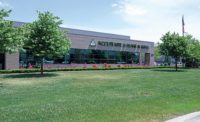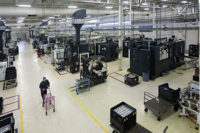
When a hurricane hits, it might be a good idea to have Pelco Products’ number on hand. Pelco Products Inc. (Edmond, OK) designs and manufactures traffic signal hardware designed to withstand the force of a hurricane and is able to ship replacement parts to hurricane-ravaged areas in days. This 25-year-old company manufactures traffic signal hardware, utility products and decorative outdoor lighting.
Owner Phil Parduhn started the company in January 1985 with his son, Steve, and “very little dollars,” Phil says. They were joined a year and half later by Phil’s other son, Jeff. Steve is now the vice president/owner, while Jeff is the controller/owner. Phil’s daughter Diana works in accounts payable.
While Phil is modest about the company’s growth, saying that when you start small, you have a long way to go, he credits the company’s success to a focus on innovation, quality and service.
Though the economy has taken its toll on businesses, Pelco is still doing well. Quality visited Pelco during the Christmas season, on what happened to be Phil’s birthday. In addition to the cookie exchange, decorations on and off the shop floor, Christmas breakfast and luncheon, the company offers something that has become all too rare. For 25 years, the company has given Christmas bonuses every year, something the Parduhn family is extremely proud of, says Operations Manager Mark Nash.
The numbers-impressive as they are-are only part of the story. A plant visit illustrates that Pelco Products is a good place to work-and not just because of the Christmas bonuses, four-day work week and a soft-serve ice cream machine in the break room, though those things can’t hurt.
It goes deeper. Employees-from 77-year-old Phil Parduhn to the operators and material handlers on the floor-take pride in their work.

Rita Rich, a member of the fabrication team, operates a drill press. Rich has more than seven years of perfect attendance at Pelco Products. Source: Pelco Products
Quality Starts on the Floor
The company is based in Edmond, OK, a quiet area just outside Oklahoma City, and works in partnership with the city of Edmond to put out its lighting products. The company began by producing traffic signal hardware-“essentially everything you see at an intersection except for the traffic light itself and the controller in the cabinet by the side of the road,” says Nash-and has since broadened its focus into utility items, and in the past several years, ornamental lighting including benches and trash receptacles. Utility, traffic and ornamental all compete with much bigger companies in all three areas, but the plant aims to do its best and supply a quality product.The company’s traffic signal hardware, still its biggest industry, is used to hold traffic signals and signs to mast arms and poles at intersections and along roadways. These mast arms and poles must be capable of withstanding strong winds and minor collisions, but also engineered to protect the public in the event that a major collision brings down a pole.
Beginning each April, Pelco ramps up for the hurricane season, the company’s busiest time. Demand skyrockets when a hurricane hits the continental United States. After Hurricane Ike, the company produced 30,000 to 40,000 assemblies in three and a half weeks, and after Katrina, the company helped Louisiana and Alabama get back on their feet with more products.
Converting more than 2,400 raw materials and parts into more than 30,000 finished goods, parts and assemblies, often highly customized to a specific local, county, state or federal government specification, does present challenges-challenges that Pelco has met. Despite the need for a complex range of highly customized parts, the company produces these made-to-order products quickly and accurately.
Though 2009 may be remembered as a less-than-stellar year for manufacturers, the company is still doing well. Since 2005, revenue is up 55.6%, top-line growth has increased by 24.9% and bottom-line profitability has been maintained-even during times of extreme volatility in metals pricing-and with only one price increase during this time.
The plant produces its products on proven fabrication machines-many more than 60 years old, a nod to Phil’s equipment auction hobby-along with new computer numerical control (CNC) machines, 3-D printers and lean-based enterprise resource planning software.

The company manufactures traffic signal hardware, utility products and decorative outdoor lighting. Source: Pelco Products
World-Class Quality Processes
When the company introduced lean manufacturing five years ago, many processes were implemented, improved or significantly overhauled. For example, witness the gage calibration program. The previous time range for recalibration was 12 to 24 months depending on the gage; the current schedule ranges from 90 days to 12 months, cutting the time between recalibration by more than 65%.Or consider the Astro-Brac, the product that started it all. Phil invented the Astro-Brac in 1968, and it is still more than one-third of the business. The Astro-Brac assembly cell has increased its throughput by more than 180% since the introduction of lean-with three less employees-and scrap and rework is down 87.3% since 2007. The shipping team is now shipping 19% more orders than in 2007, with fewer mistakes than ever and with 50% less staffing.
With the renewed emphasis on quality, the Astro-Brac product line cable pull testing went from random quality checks to load testing the first cables out of the manufacturing cell at the start of each shift and retesting all cable reel changes. This process went from a five Sigma level to Six Sigma, ensuring that no failures occur that might endanger the public.
In the focus on quality, employees were essential in improving the company. Operators are crucial to the plant’s success: “It is all about the operators here at Pelco,” says Nash, and management tells employees it is okay to say what they think. As a result, team leaders, and even operators, will offer improvements as well as ask what the company’s goals are for growth.
For example, assembly operator Robert Wilson suggested turning one aisle of warehouse rack 90 degrees to create a clear separation between the warehouse and assembly areas, resulting in more than 250-square-feet of additional floor space for assembly and reduced forklift traffic in the area. And the powdercoat team asked management about conducting kaizen in their area; the team previously coated an average of 767 parts per day but now coats an average of 3,429 parts per day.
So how is the company able to make these numbers? Hint: they aren’t doing it alone.

Team Leader Travis Casto (left) discusses a wiring assembly with Sherri Ervin (right) and Maritza Calderon (center). Source: Pelco Products
Employees Tell All
Plant floor team leaders Earnest Brumley and Travis Casto said the company has made their job easier, and made it easier to put out good parts on time. Though at first they were slow to explain, as they warmed up, the two could not say enough about Pelco’s success.They explained that the quality assurance focus extends beyond the quality assurance office located on the plant floor. For one thing, Quality Assurance Manager John Miller is often out of his office, spending the majority of his time on the plant floor to see how things are moving.
In his career, Miller has worked at a variety of plants, but wherever he goes, he has spread his ethos of hands-on management and openness. Early in his 35-year career, he witnessed his company’s president successfully take this approach and thought, “If it works for him, it could work for me.”
It definitely has. Miller’s arrival in 2008 has improved the plant’s numbers, and he has a good relationship with his staff.
“They know I work for them,” says Miller, who has been with Pelco since July 2008.
And the staff believes in spreading the credit around. Though many employees told Quality how Miller had brought about quality improvements, Miller himself credited the employees on the floor with the improved quality numbers, specifically “the willingness of the people on the floor to take ownership and allow themselves to be empowered.”
Everyone at the plant, from engineers printing 3-D parts to the team leaders on the shop floor, is quick to share the credit with others. The team leaders credited their staff for their department’s success and said work instructions and other elements Miller introduced have contributed to the plant’s success.
When he arrived at Pelco, Miller got out on the floor and asked people how they did their jobs. He worked with the team leaders on the floor to develop new One Point Lesson-based work instructions, short visual presentations on a single point that are created with operators performing the tasks. He works with the team leaders until the work instruction development allows them to develop these tools on their own. This training and documentation effort ensures a higher quality of parts through standardization and more efficient problem solving when issues arise.
“We’ve got full buy-in, there’s no doubt about that,” Miller says.
Brumley says Miller also stands up for his team, making sure vendors deliver quality parts to Pelco so they can make quality parts.
Casto agrees. “It’s easier for us to be successful.”
Both Brumley and Casto started out on the line and worked their way up to team leader positions. In the past five years, Casto says the company has gone from a 25 mph zone to the highway. Processes have been streamlined, making it easier for them to produce parts quickly and accurately. In fact, Brumley’s Astro-Brac department-which handles almost 40% of the business-received their last customer complaint more than a year earlier.
“It’s a great place to work for a lot of people,” Casto says.

Copper thieves steal anything they can sell to scrap dealers. The Pelco Products anti-theft cable retainer is installed between the pole and foundation, clamping the copper cables in place. The cost of the retainer and installation labor is a fraction of the cost of cable repair or replacement. Source: Pelco Products
Plant of the Year
Pelco takes care of their customers too. A customer once had a problem with another manufacturer’s light fixture that mated with Pelco's ornamental poles at 4:30 p.m. on Valentine’s Day, but Pelco made sure that the light fixtures were modified and were back on the job site the next morning. The customer told Pelco that their competitors might have taken six weeks to solve the same problem.The company tries very hard to be responsive to situations. The innovation, quality and service (IQS) strategy has been an official motto for the past several years, though it has been the company’s philosophy all along. Al Parduhn, Phil’s father, often told him, “Business goes where it’s invited and stays where it’s appreciated.”
Indeed, the company tracks its customer successes carefully. The primary metric used to measure success on the floor and identify areas to improve is quality shipments to customers, a measure that compares error-free orders shipped on-time against total orders shipped on a monthly basis. The vast majority of customers order with a soft due date, so measuring exact on-time vs. late orders had not been a major concern in the past. However, Pelco’s reputation for shorter lead times led customers to expect more, prompting Pelco to measure against the date they promised on an order.
Initially, this seemed daunting. Pelco customizes more than 80% of its orders on a daily basis and ships about 200,000 component parts as assemblies into customer specifications each month. Indeed, quality shipments to the customer were initially seen in the 40% to 50% success range. Since the company changed its focus to floor-based root cause analysis with its teams, this metric has improved to the more than 80% range-close to a 100% increase in on-time quality shipments to the customer.
Success was not a response to stagnant or reduced sales either. The company experienced double-digit growth three out of the past six years.
Many factors have contributed to the plant’s success, but one stands out. “If you respond with a quality product,” Nash says, “a customer will come back to you.”Q
For more information, visitwww.pelcoinc.com.

Pelco Products Inc.
Location: Edmond, OKEmployees: 146
Type of product manufactured: Traffic signal hardware, ornamental lighting and accessories, and utility industry brackets and accessories.
Family-owned business started in 1985 by Phil Parduhn, and his son, Steve.
Along with a new Web site, Pelco Products can be reached via LinkedIn, Twitter, YouTube and Facebook.

It's easy being green
Pelco has been incorporating green practices for more than 20 years, resulting in both Earth- and employee-friendly practices.The company uses 100% wind power, powdercoat instead of wet paint, energy efficient lighting, programmable thermostats, infrared heaters and high velocity/low speed fans for cooling. The plant also recycles paper, cardboard, plastic, aluminum and steel.
Pelco uses a four-day work schedule, allowing plant employees to put in more hours Monday through Thursday and then have Fridays off. If overtime is needed, it can then be done on Friday.



